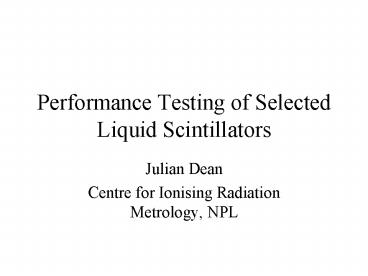Performance Testing of Selected Liquid Scintillators PowerPoint PPT Presentation
Title: Performance Testing of Selected Liquid Scintillators
1
Performance Testing of Selected Liquid
Scintillators
- Julian Dean
- Centre for Ionising Radiation Metrology, NPL
2
Colloid (Emulsion) Counting
- Heterogeneous sample preparation technique
- Widely used by user community
- Wide range of commercial liquid scintillators
commercially available - Data provided often limited
3
Aim of project
- To derive sample uptake/efficiency data for four
specific liquid scintillators with a range of
nuclides and matrices
4
Scintillators
- Readysafe (Beckman Coulter)
- Ultima Gold AB (Packard)
- Uniscint BD (National Diagnostics)
- Unisolve 100 (NBS Biologicals)
- Frequently used in-house at NPL and found
reliable
5
Radionuclide standards
Radionuclide Calibration Laboratory Activity (Bq)
Tritium Amersham 1500
Sulphur-35 Amersham 150
Iron-55 NPL 6400
Strontium-90 NPL 450
Technetium-99 Amersham 1000
Plutonium-238 NPL 2000
Plutonium-239 NPL 2000
6
Matrices
Radionuclide Matrices examined
Tritium Water
Sulphur-35 Water, 0.1 M HCl
Iron-55 HCl (0.1 M and 1 M)
Strontium-90 1 M HNO3, HCl (0.1 M and 1 M)
Technetium-99 NH4OH (0.01 M, 0.1 M and 0.5 M)
Plutonium-238 HNO3 (0.5 M, 1 M and 2 M)
Plutonium-239 HNO3 (0.5 M, 1 M and 2 M)
7
Assessment of sample uptake
- Matrix added in 0.5 ml increments to scintillant
(10 ml) until system became cloudy and/or
unstable (ambient temperature) - Each sample of scintillator taken from a single
batch
8
Sample preparation
- For each permutation of scintillant, radionuclide
and sample matrix, samples were prepared at three
volume levels 0.5 g, 1.5 g and the maximum
uptake level - In each case 0.1 g of standard solution added to
vial and diluted with appropriate matrix - All vials topped up to 18 g with liquid
scintillator - All samples prepared in triplicate
- Background samples prepared for each permutation
9
Counting
- All samples counted on
- 1. Wallac Rackbeta 1219
- 2. Canberra Packard Tricarb
- Detection Efficiencies and Merit Values
determined - Merit Value Detection Efficiency x proportion
of aqueous phase in vial (as percentages)
10
(No Transcript)
11
(No Transcript)
12
(No Transcript)
13
(No Transcript)
14
(No Transcript)
15
Conclusions
- 1. Useful data generated for planning dilution
checks and deriving approximate activity
concentrations for some nuclides - 2. No product universally superior to others but
Ultima Gold is best overall for nuclides/matrices
studied - 3. Some uptake data conflict with manufacturers
data - 4. Similar detection efficiencies found for the
two LS counters used
16
Suggestions
- 1. Look at other scintillants, nuclides and
matrices - 2. Look at, e.g., temperature effects, count-rate
stability, variations between batches - 3. Pool user information into one database
- 4. Supplementary physical measurements (e.g.
micellar size, formation)

